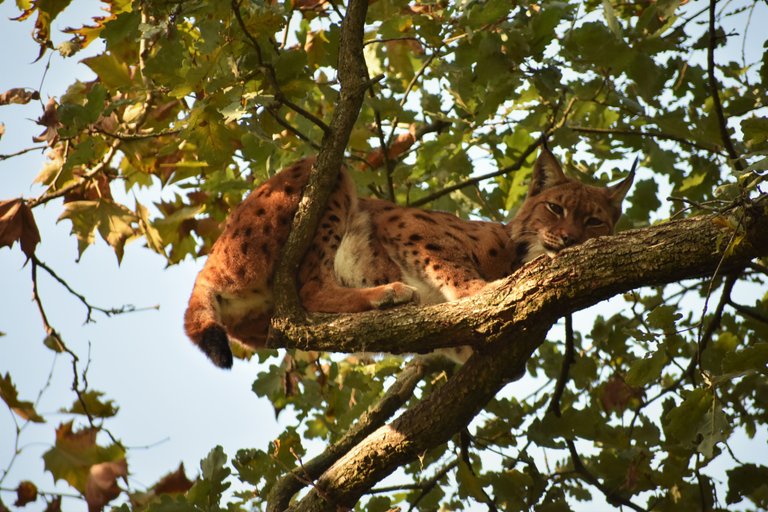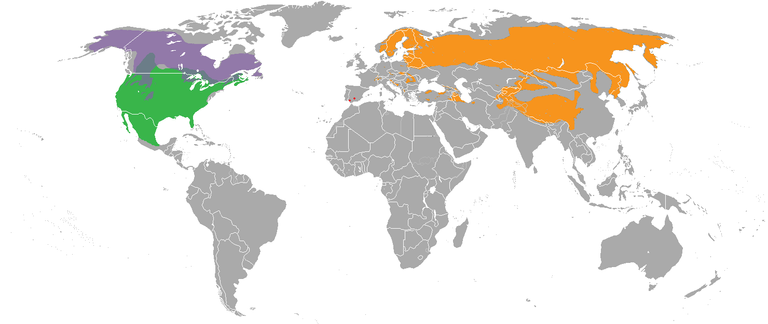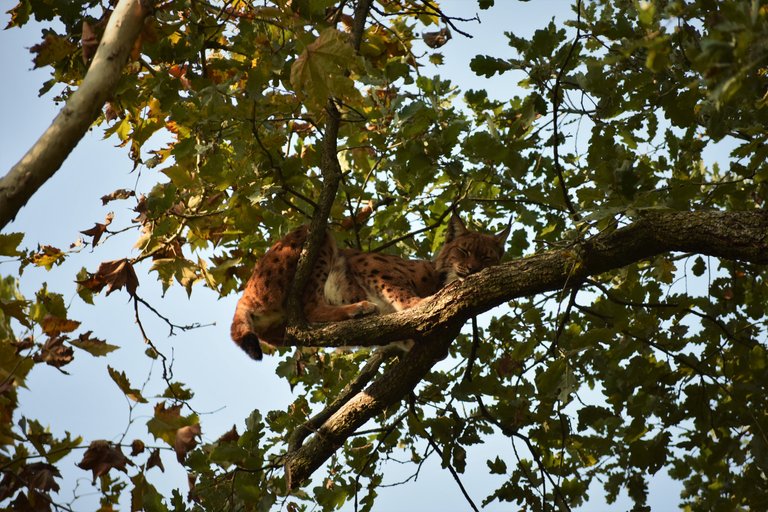SpaghettiPhoto - Lynx lynx [ENG/ITA]
 |  |
|---|
The lynx is a medium-sized carnivorous mammal, belonging to the Felidae family, widespread in most of the emerged lands of the northern hemisphere. It is an animal very similar to a large wild cat, but it differs from this in strength, aggressiveness and some peculiar traits that make it easily distinguishable.
To date, there are four different species belonging to this genus: the European lynx (Lynx lynx), the Iberian lynx (Lynx pardinus), the red lynx (Lynx rufus) widespread in america and the Canadian lynx (Lynx canadensis). In the past, each of these species had numerous subspecies, but in recent centuries the progressive decrease in the number of specimens has led naturalists to bring together the remaining groups into larger categories. Furthermore, this subdivision is sensible only with regard to the European lynx which, living in areas also very distant and isolated, has managed over time to create groups of individuals with different characteristic and different genetic pools. In America and Russia, on the other hand, the lower human population density has allowed the lynx to colonize a single and enormous continuous territory, which limits the formation of isolated groups.
La lince è un mammifero carnivoro di medie dimensioni, appartenente alla famiglia Felidae, largamente diffuso nella maggior parte delle terre emerse dell’emisfero boreale. Si tratta di un animale molto simile ad un grosso gatto selvatico, che differisce però da questo per forza, aggressività e alcuni tratti peculiari che lo rendono facilmente distinguibile.
Ad oggi esistono quattro specie diverse appartenenti a questo genere: la lince europea (Lynx lynx), la lince iberica (Lynx pardinus), la lince rossa (Lynx rufus) diffusa in america e la lince canadese (Lynx canadensis). In passato, ciascuna di queste specie contava numerose sottospecie, ma negli ultimi secoli la progressiva diminuzione del numero di esemplari ha portato i naturalisti a riunire i gruppi rimasti in categorie più ampie. Inoltre, questa suddivisione risulta sensata solo per quanto riguarda la lince europea che, vivendo in zona anche molto distanti e isolate, è riuscita nel tempo a creare gruppi di individui con pool genetici caratteristici e diversi tra loro. In America e in Russia, invece, la minor densità di popolazione ha permesso alla lince di colonizzare un unico ed enorme territorio continuo, che limita la formazione di gruppi isolati.

ORIGINAL WORK BY SPAGHETTISCIENCE
If you need this or other images, just ask!
The European lynx is characterized by an average weight of 35 kilograms, an average length of 130 centimeters and a height at the withers of 60 centimeters. If from a distance it is possible to exchange the lynx for a large wild cat, approaching it will be possible to notice some peculiar characteristics that make it absolutely recognizable, such as the small mane around the head or the typical tufts of black fur over the ears. Even the squat and soft legs are characteristics of this animal, and are indispensable for moving successfully in fresh snow. Thanks to the sharp nails that he usually brings back and "hidden" he turns out to be a skilled climber. The lynx live in nature on average about ten years, but in protected environments older specimens have also been observed.
The lynx lives mainly in areas rich in forests, where however there are also portions of rocky terrain rich in shelters for the winter. In fact, if during the hot season the lynx prefers to rest on top of the trees, to survive the winter the shelters dug in the ground or in the rock are essential.
Currently, although the lynx is not considered an animal in danger of extinction, its range in Europe is extremely reduced and divided. This is because, being an extremely territorial predator, especially in past years the attacks on dogs that were wandering in their territory were not infrequent; this led the lynx to be persecuted by humans. Furthermore, his fur has long been the object of the desire of poachers.
La lince europea si caratterizza per un peso medio di 35 chilogrammi, una lunghezza media di 130 centimetri ed un’altezza al garrese di 60 centimetri. Se da lontano è possibile scambiare la lince per un grosso gatto selvatico, avvicinandosi sarà possibile notare alcune caratteristiche peculiari che la rendono assolutamente riconoscibile, come la piccola criniera attorno alla testa o i tipici ciuffi di pelo nero. Anche le zampe tozze e soffici sono caratteristiche di questo animale, e risultano indispensabili per muoversi con successo nella neve fresca. Grazie alle unghie affilate che porta solitamente ritratte e “nascoste” risulta essere un abile arrampicatrice. Le linci in natura vivono mediamente una decina di anni, ma in ambienti protetti sono stati osservati anche esemplari più anziani.
La lince vive soprattutto in zone ricche di foreste, dove siano però presenti anche porzioni di terreno roccioso e ricco di ripari per l’inverno. Infatti, se durante la stagione calde la lince preferisce riposare in cima agli alberi, per sopravvivere all’inverno sono fondamentali i ripari scavati nel terreno o nella roccia.
Attualmente, seppur la lince non sia considerato un animale in pericolo di estinzione, il suo areale in Europa risulta estremamente ridotto e frazionato. Questo perché, trattandosi di un predatore estremamente territoriale, soprattutto negli anni passati non erano infrequenti gli attacchi a cani che, vagabondando, entravano nel loro territorio; questo ha portato la lince ad essere perseguitata dagli umani. La sua pelliccia, inoltre, è stata a lungo oggetto del desiderio dei bracconieri.

Image CC0 Creative Commons- Source
From an ethological point of view, the lynx feeds mainly on small animals such as rodents, small birds and various invertebrates. However, especially during the winter period, it does not disdain even larger animals such as moose, deer and roe deer; because of the snow, in fact, these animals are more clumsy and easier to catch. A particular feature from this point of view is that the lynx never pursues its prey: if the first attack fails, usually the hunt ends. This is because the physical structure of the lynx is suitable for making quick and energetic shots of a few meters, useful for surprising and killing the prey instantly; the pursuit, on the contrary, is a prolonged activity that is impossible to sustain.
Mating takes place during spring, and gestation lasts about 60 days. After two months, two to four cubs are born already covered with fur, but absolutely not able to face life. The walking abilities are in fact extremely reduced, and the teeth are not adequately developed. The sociability of the lynx does not provide for the formation of stable pairs, although in rare cases some lasting pairs have been observed, and the females, after mating, take care of the young themselves. Precisely for this reason the reproductive season is reduced to the few months preceding spring: this allows the pups to give birth during the first warm, when for the mother it becomes easier to search for food to keep itself and the little ones. After nine months the puppies begin to be sufficiently developed, and they are able to survive the new winter in the company of their mother, before becoming full-fledged adults.
The biggest enemy of the lynx is the wolf that, moving in a pack, always manages to get better. Other dangers are represented by bears and birds of prey, although adult individuals are usually able to avoid them effectively.
Dal punto di vista etologico, la lince si ciba principalmente di piccoli animali quali roditori, piccoli volatili e invertebrati vari. Soprattutto durante il periodo invernale, però, non disdegna anche animali più grossi come alci, cervi e caprioli; a causa della neve, infatti, questi animali risultano più impacciati e più facili da catturare. Una caratteristica particolare da questo punto di vista è che la lince non insegue mai la sua preda: se il primo attacco fallisce, solitamente la caccia finisce. Questo perché la struttura fisica della lince è adatta a compiere veloci ed energici scatti di pochi metri, utili a sorprendere e uccidere all’istante la preda; l’inseguimento, al contrario, è un’attività prolungata che risulta impossibile da sostenere.
Gli accoppiamenti avvengono durante la primavera, e la gestazione dura circa 60 giorni. Trascorsi due mesi, nascono dai due ai quattro cuccioli già ricoperti di pelo, ma assolutamente non in grado di affrontare la vita. Le capacità deambulatorie sono infatti estremamente ridotte, e la dentatura non sviluppata adeguatamente. La socialità della lince non prevede la formazione di coppie stabili, sebbene in rari casi siano state osservate alcune coppie durature, e le femmine, dopo l’accoppiamento, si prendono cura da sole dei piccoli. Proprio per questo motivo la stagione riproduttiva è ridotta ai pochi mesi che precedono la primavera: questo permette di partorire i cuccioli durante i primi caldi, quando per la madre diviene più semplice la ricerca di cibo per mantenere sé stessa e i piccoli. Trascorsi nove mesi i cuccioli iniziano a essere sufficientemente sviluppati, ed in grado di sopravvivere all’inverno in compagnia della madre, prima di diventare adulti a tutti gli effetti.
Il più grande nemico della lince è il lupo che, muovendosi in branco, riesce sempre ad avere meglio. Altri pericoli sono rappresentati da orsi e rapaci, sebbene gli individui adulti siano solitamente in grado di evitarli in modo efficace.

ORIGINAL WORK BY SPAGHETTISCIENCE
If you need this or other images, just ask!
In Europe it has become quite rare to be able to observe lynxes in the wild, the decrease in the number of specimens combined with the natural shyness of the lynx, in fact, makes the meetings infrequent even in the woods where their presence is known. However, there are now numerous protected areas, such as the Abruzzo National Park, where observing carefully and lurking in silence for long periods, it is still possible to see these beautiful animals among the vegetation. These photos were taken right in this park.
Nowadays, with the gradual abandonment of rural areas, the end of poaching and the implementation of various protection policies, the lynx is rapidly regaining the European continent, and it cannot be ruled out that in the coming years the encounters with humans can be more frequent. In Italy, the Apennine population is progressively climbing towards the Alps, and in turn the Balkan population is moving, still in the Alps, towards the west; this could lead to the encounter of two populations divided for a long time; from the genetic point of view this represents an important turning point, as it could originate a new and important genetic diversity, able to significantly improve the genetic pool of the European lynx.
The genetic isolation, in fact, has led over the years to the positive selection of the most suitable characters for survival in a specific place; this allows the animals to be perfectly performing in their environment, but also makes them extremely "delicate" in front of a great climate change. For example, in the Apennine lynxes a progressive decrease in the size of the legs has been observed: this makes them more agile and more suited to the type of soil and environment present. However, as mentioned, the squat legs represent an important advantage in case of fresh snow; if in the future sudden climatic changes should make these areas more susceptible to the presence of snow, these lynxes would be in great difficulty. For this reason, the encounter with distant populations, characterized by different genetic traits, could lead to a genetic mixing useful to the whole species.
In Europa è diventata abbastanza raro riuscire ad osservare delle linci in natura, la diminuzione del numero di esemplari combinata con la naturale timidezza della lince, infatti, rende gli incontri poco frequenti anche nei boschi dove è nota la loro presenza. Tuttavia, esistono ormai numerose aree protette, come il Parco Nazionale d’Abruzzo, dove osservando con attenzione e appostandosi in silenzio per lunghi periodi, è ancora possibile scorgere tra la vegetazione questi bellissimi animali. Queste foto sono state scattate proprio in questo parco.
Oggi, con il progressivo abbandono delle aree rurali, la fine del bracconaggio e l’attuazione di diverse politiche di tutela, la lince sta riconquistando velocemente anche il continente europeo, e non è affatto da escludere che nei prossimi anni gli incontri con l’uomo possano farsi più frequenti. In Italia, la popolazione appenninica sta progressivamente risalendo verso le Alpi, e a sua volta la popolazione balcanica si sta muovendo, sempre sulle Alpi, in direzione Ovest; questo potrebbe portare preso all’incontro di due popolazioni a lungo divise; dal punto di vista genetico questo rappresenta un’importante punto di svolta, in quanto potrebbe originarsi una nuova ed importante diversità genetica, in grado di migliorare sensibilmente il pool genetico della lince europea.
L’isolamento genetico, infatti, ha portato negli anni alla selezione positiva dei caratteri più adatti alla sopravvivenza in un posto specifico; questo permette agli animali di risultare perfettamente performanti nel loro ambiente, ma li rende anche estremamente “delicati” difronte ad un grande cambiamento climatico. Per esempio, nelle linci appenniniche si è osservata una progressiva diminuzione nelle dimensioni delle zampe: questo le rende più agili e più adatte al tipo di terreno e ambiente presente. Tuttavia, come detto, le zampe tozze rappresentano un importante vantaggio in caso di neve fresca; se in futuro degli improvvisi cambiamenti climatici dovessero rendere queste zone più suscettibili alla presenza di neve, queste linci si troverebbero in grande difficoltà. Per questo, l’incontro con popolazioni lontane, caratterizzate da diversi tratti genetici, potrebbe portare ad un mescolamento genetico utile a tutta la specie.
IUCN Red List

LC = Least Concern - Source
References
- IUCN Red List.
- Animal Diversity Web.
- Henrik Andrén et al. (2002). Estimating total lynx Lynx lynx population size from censuses of family groups.
- Krzysztof Schmidt et al. (2011). The importance of genetic variability and population differentiation in the Eurasian lynx Lynx lynx for conservation, in the context of habitat and climate change.
